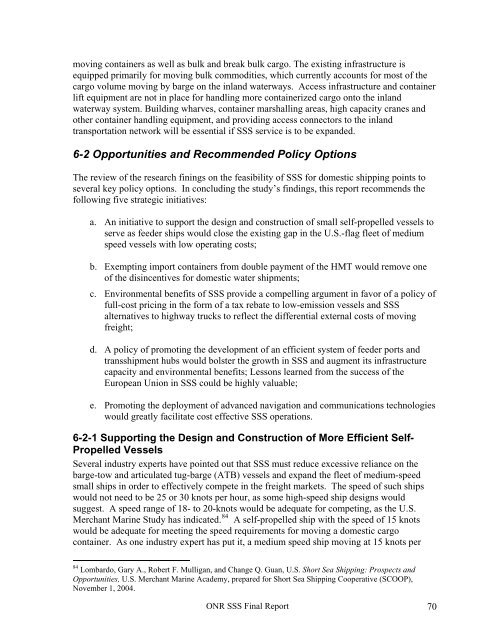moving containers as well as bulk and break bulk cargo. The existing infrastructure isequipped primarily for moving bulk commodities, which currently accounts for most <strong>of</strong> thecargo volume moving by barge on the inland waterways. Access infrastructure and containerlift equipment are not in place for handling more containerized cargo onto the inlandwaterway system. Building wharves, container marshalling areas, high capacity cranes andother container handling equipment, and providing access connectors to the inlandtransportation network will be essential if SSS service is to be expanded.6-2 Opportunities and Recommended Policy OptionsThe review <strong>of</strong> the research finings on the feasibility <strong>of</strong> SSS for domestic shipping points toseveral key policy options. In concluding the study’s findings, this report recommends thefollowing five strategic initiatives:a. An initiative to support the design and construction <strong>of</strong> small self-propelled vessels toserve as feeder ships would close the existing gap in the U.S.-flag fleet <strong>of</strong> mediumspeed vessels with low operating costs;b. Exempting import containers from double payment <strong>of</strong> the HMT would remove one<strong>of</strong> the disincentives for domestic water shipments;c. Environmental benefits <strong>of</strong> SSS provide a compelling argument in favor <strong>of</strong> a policy <strong>of</strong>full-cost pricing in the form <strong>of</strong> a tax rebate to low-emission vessels and SSSalternatives to highway trucks to reflect the differential external costs <strong>of</strong> movingfreight;d. A policy <strong>of</strong> promoting the development <strong>of</strong> an efficient system <strong>of</strong> feeder ports andtransshipment hubs would bolster the growth in SSS and augment its infrastructurecapacity and environmental benefits; Lessons learned from the success <strong>of</strong> theEuropean Union in SSS could be highly valuable;e. Promoting the deployment <strong>of</strong> advanced navigation and communications technologieswould greatly facilitate cost effective SSS operations.6-2-1 Supporting the Design and Construction <strong>of</strong> More Efficient Self-Propelled VesselsSeveral industry experts have pointed out that SSS must reduce excessive reliance on thebarge-tow and articulated tug-barge (ATB) vessels and expand the fleet <strong>of</strong> medium-speedsmall ships in order to effectively compete in the freight markets. The speed <strong>of</strong> such shipswould not need to be 25 or 30 knots per hour, as some high-speed ship designs wouldsuggest. A speed range <strong>of</strong> 18- to 20-knots would be adequate for competing, as the U.S.Merchant Marine Study has indicated. 84 A self-propelled ship with the speed <strong>of</strong> 15 knotswould be adequate for meeting the speed requirements for moving a domestic cargocontainer. As one industry expert has put it, a medium speed ship moving at 15 knots per84 Lombardo, Gary A., Robert F. Mulligan, and Change Q. Guan, U.S. Short Sea Shipping: Prospects andOpportunities, U.S. Merchant Marine Academy, prepared for Short Sea Shipping Cooperative (SCOOP),November 1, 2004.ONR SSS Final Report 70
hour could deliver the same container 500 miles away in about 1.5 days (less than 34 hours)considering that an average truck that is subject to the HOS rules drives 500 miles per day.The small size <strong>of</strong> the vessel would also enable it to match the crew size advantages <strong>of</strong> ABTs.85 As noted in Section 5, the design could incorporate some <strong>of</strong> the features <strong>of</strong> ATBs tobenefits from lower crewing requirements.Medium-speed speed small ships will also grow more competitive with trucking as oil pricesrise. As oil prices rise, operating costs go up as well. Rising speed tend to raise fuelconsumption and operating costs at an exponential rate. It has been estimated that in the past15 years the average speed <strong>of</strong> the world marine vessel fleet has grown from 20 knots to 29knots. This 45 percent increase in speed has been associated with the doubling <strong>of</strong> the fuelconsumption per unit <strong>of</strong> cargo (a 100 percent increase.) 86 It is reasonable to assume that asoil prices rise, shippers may find it easier to trade <strong>of</strong>f higher-speed freight modes for loweroperating costs.Other SSS studies have concluded that the current inventory <strong>of</strong> tug-barge vessels mayrepresent a class <strong>of</strong> service vessels too slow to compete effectively for capturing a significantshare <strong>of</strong> existing road and rail traffic. The have suggested that support for construction <strong>of</strong>higher speed ships, perhaps in the 20-knot range, would be effective in promoting SSS for abroader range <strong>of</strong> cargo and would close the existing gap in the small medium-speed vesselswith low operating costs. 876-2-2 Removing the Disincentives for Domestic Marine Shipping byExempting Import Containers from Double Payment <strong>of</strong> the HMTEfforts to seek a waiver <strong>of</strong> the HMT imposed on import containers shipped by water fordomestic distribution continue. This exemption would remove the adverse impact <strong>of</strong> HMTon domestic water shipments as it taxes the same load twice, whereas the equivalent trucktransportation <strong>of</strong> a load does not involve similar fees.Current efforts in support <strong>of</strong> the exemption include H.R. 3319 to amend the IRS code toexempt domestic intermodal cargo containers from the HMT. The American Association <strong>of</strong>Port Authorities (AAPA) has drafted several position papers and supported legislativeinitiatives in support <strong>of</strong> the waiver, maintaining that only a small fraction <strong>of</strong> the HMTcollection on domestic shipments comes from the intermodal cargo. After the SupremeCourt found in 1998 that imposing HMT on the U.S. exports was unconstitutional, theremaining cargo base subject to the HMT consisted <strong>of</strong> imports, domestic cargo, cargoprocessed and fabricated at Free Trade Zones (FTZ), and cruise ships using the coastal andinland waterways. The AAPA document advocating the removal <strong>of</strong> the HMT shows that85 Comments <strong>of</strong> Mr. John Bobb, USCG, Chief, Oceans & <strong>Transportation</strong> Branch, <strong>Office</strong> <strong>of</strong> WaterwaysManagement, Journal <strong>of</strong> Commerce Conference on Marine Highways, Jacksonville, Florida, April 1-2, 2009.Mr. Bobb suggested that the best way to meet this need would be to have a competitive grants process fordesign <strong>of</strong> a small ship.86 <strong>Transportation</strong> Economics Management Systems, Inc. (TEMS), Impact <strong>of</strong> High Oil Prices on Freight<strong>Transportation</strong>: Mode Ship Potential in Five Corridors – Technical Report, Prepared for MARAD, USDOT.October 2008.87 Institute for Global Maritime Studies, America’s Deep Blue Highway: How Coastal Shipping Could ReduceTraffic Congestion, Lower Pollution, and Bolster <strong>National</strong> Security, September 2008.ONR SSS Final Report 71
















